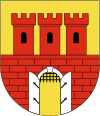Chodziez
| Chodzież | |||
|---|---|---|---|

View of Chodzież
|
|||
|
|||
| Coordinates: 52°59′N 16°54′E / 52.983°N 16.900°E | |||
| Country |
|
||
| Voivodeship | Greater Poland | ||
| County | Chodzież County | ||
| Gmina | Chodzież (urban gmina) | ||
| Area | |||
| • Total | 12.77 km2 (4.93 sq mi) | ||
| Population (2009) | |||
| • Total | 19,525 | ||
| • Density | 1,500/km2 (4,000/sq mi) | ||
| Postal code | 64-800 | ||
| Website | http://www.chodziez.pl | ||
Chodzież [ˈxɔd͡ʑeʂ] (German: Kolmar) is a town in northwestern Poland with 20,400 inhabitants (1995). Situated in the Chodzież County, Greater Poland Voivodeship (since 1999), previously in Piła Voivodeship (1975–1998).
In the German language, it has traditionally been known as Chodziesen, after 1879 Kolmar in Posen. This name may be falling into disuse over time, though it can still be found in current use in Germany in some cases.
Chodzież is located in the northern part of Greater Poland (western Poland), in the Chodzieskie lakelands. The most important characteristics of this lakeland area are its typical postglacial landforms, forests of pines and mixed woodlands, and lakes. For this reason, the city's surroundings are known as "the Switzerland of Chodzież".
Five kilometers west of Chodzież, at the edge of the Chodzieskie lakelands, Mt. Gontyniec (German: Tempel Berg) rises 192 meters above sea level as the highest peak in a chain of moraine hills; at the same time it has the highest elevation in northern Poland. Deep valleys and ridges covered with a 100-year-old beech forest ensure diversified surroundings.
Within the five square miles (13 km2) of city area, there are three lakes: Miejskie, 1 km2 (English: Town lake, 0.4 mile²), Karczewnik, 0.25 km2 (0.097 sq mi), and Strzeleckie, 0.18 km2 (0.069 sq mi), which make up about 13% of the total town area.
...
Wikipedia



